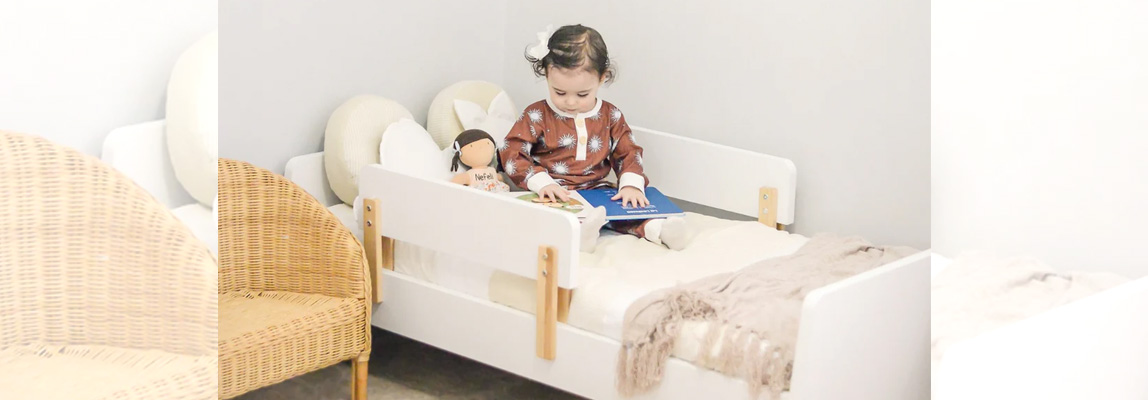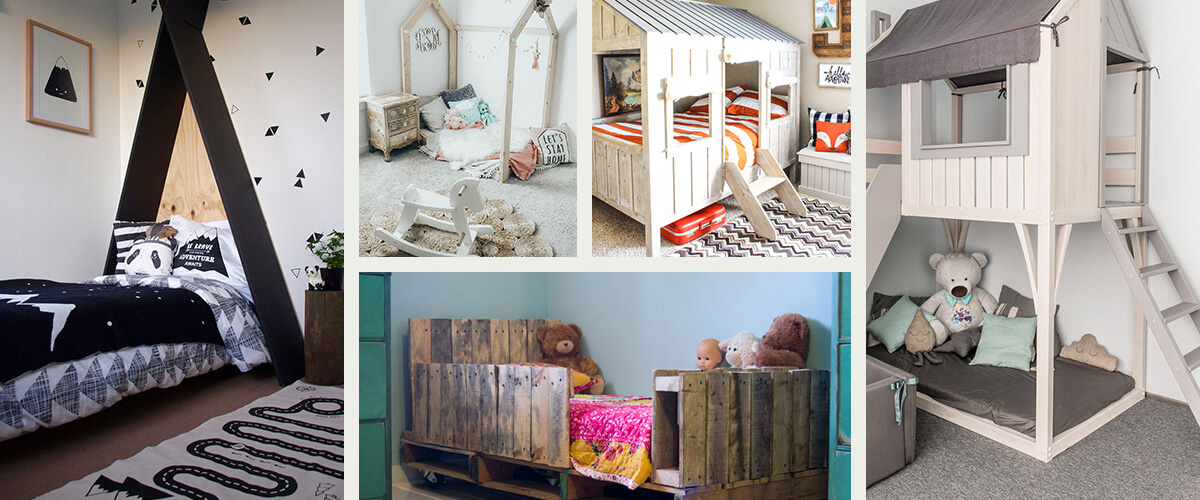
There’s no set time for when it’s best to switch your child from a crib to a toddler bed; in fact, the average age for introducing a toddler bed varies widely, between 18 months and 3.5 years old. There are a few factors to consider before you make the transition – most important, making sure your child is developmentally ready for the move.
For example, if your child hasn’t mastered the art of self-control and doesn’t understand the importance of staying in their bed or room at night, they may not be ready. That said, you’ll need to transition your toddler to a bed when they’re too big to sleep in their crib anymore, which is when they’re around 35 inches tall or their chest is higher than the crib railing.
And if your toddler starts taking a very active interest in trying to climb out of their crib (or they’re already successfully doing so!), that’s another surefire sign it’s time to make the switch – your toddler falling or jumping out of their crib is a real safety concern. But before moving them to a bed, lower the crib mattress as far as possible if you haven’t already.
There’s a good chance your child may also start asking for a “big kid bed,” especially if they have an older sibling, which is a strong indication they’re emotionally ready to make the switch.
Signs your child is ready to transition to a toddler bed
If you notice your toddler doing any of the following, it’s likely time to make the switch:
- They’re successfully climbing out of their crib
- Their chest is higher than the crib railing. Even if they’re not yet a climber, once your child’s nipples are in line with the top of the crib railing when standing – typically when they’re around 3 feet tall – consider moving them to a bed.
- They’ve expressed interest in a big kid bed. If your child is asking to make the move from a crib, that’s a good sign they’re cognitively and emotionally ready for the transition.
- They’re fully potty-trained at night, or working toward it. For many kids, potty training overnight comes after daytime potty training. But once they’re no longer wearing diapers or training pants to sleep, they’ll need easy access to a bathroom.
What if you’ve made the switch, and it’s not going well? Some toddlers simply aren’t ready for transitioning to a toddler bed yet, and that’s okay. It takes a certain amount of cognitive development for your child to understand that a bed has imaginary boundaries they must stay within. Your child may not be ready for a toddler bed if they:
- Are suddenly taking a long time to fall asleep at night
- Get out of bed many times throughout the night
- Start wandering around the house
As with potty training, sometimes it’s worth taking a step back and bringing back the diapers – or in this case, the crib – and trying again later. Just be sure you don’t present the reappearance of the crib as a step backward in development or a punishment.
Should my child move from crib to toddler bed before a new sibling arrives?
That’s up to you. Another reason parents make the switch from a crib to a toddler bed is the impending arrival of another baby – whether that’s because you need the crib or you’re looking to accomplish this milestone before a sibling arrives.
If this is your situation, try to move your toddler to their bigger bed a few months before your baby’s due date. This will give your older child some time to get settled and comfortable before they see the baby taking over “their” space.
Depending on your toddler’s age, you might also consider delaying the switch until the new baby is around 3 or 4 months old. Your newborn will likely be spending those early months sleeping in a bassinet in your bedroom anyway, and your toddler will have time to adjust to the new baby, potentially making the transition to a bed easier.
It’s important to base the timing of the transition on your child’s readiness rather than on the need to free up the crib. Many parents find out too late that it would have been easier to borrow or buy another crib rather than move their older child to a bed before they were ready.
Some children adjust readily to this change, while others have a hard time with it. Every child is different. It’s not unusual, though, for firstborn children to resist the transition from the crib to the bed. Later-born children often have an easier time making the switch because they want to be just like their older brother or sister.
Tips for easing the transition to a toddler bed
If you’ve decided to make the switch, here’s some advice to keep in mind:
Put the new bed in the same place your toddler’s crib used to be. If you’re using a twin bed, you may want to wait on switching to grown-up sheets and blankets that are tucked in. Your child may find it soothing to continue sleeping with their old crib blanket, even if it’s too small. And don’t forget to put up a guardrail (if the bed you’ve purchased doesn’t already come with one installed) to prevent your newly liberated toddler from falling out of bed.
Have your toddler help you pick out their new bed, if you’re buying a new one. If you’re inheriting a used bed, you can emphasize its previous owner if that person is someone your child knows: “This was your cousin’s bed, and now it’s yours! You’re almost as big as him now!”
Let your toddler shop with you for new sheets featuring their favorite characters, and encourage them to show their “big-kid bed” to friends and family. Make sure you have a safe mattress that’s compatible with the new bed. Or, you can buy a special “toddler bed,” which uses a crib mattress but has built-in guardrails. Many come in fun themes, such as cars and castles.
Time it right. In addition to making sure your child is developmentally ready, make sure the transition to the bed doesn’t coincide with any other big lifestyle changes, such as potty training, moving, or bringing home a new baby.
Set physical boundaries. Late-night visits from your child might be inevitable at the beginning, but tell them that they need to stay in bed once the lights go out. You can even set up an “invisible gate” if you think it’ll help them understand the rules better. If they try to escape a few times and call for you in the middle of the night, simply tell them everything’s okay, give them a kiss, and walk them back to bed. It might take a few tries, but they’ll catch on eventually.
Maintain your routine. The bed may change, but the bedtime routine doesn’t have to. Keep your nighttime routine consistent with how it was in the crib – bath, teeth brushing, books – so your child has a sense of familiarity and knows when they’re expected to settle in for the night.
Stick to your guns. Once in a while it’s okay to bend the rules and let your child cuddle up in your bed (say, they’re sick or had a bad day). But it’s best to develop a plan and stick with it as often as possible. Your child will thrive on the consistency of a routine just as much as you will.
Make sure your child is comfortable. This might mean buying a new nightlight or leaving a light on in the hallway if they’re newly afraid of the dark, or letting them sleep with a comfort object such a lovey or stuffed animal during the night.
Reward good behavior. If your child stays in their bed all night, tell them how proud you are of them so they’re inclined to do it again. It’s up to you whether you want to use prizes or other incentives to encourage good listening.
Don’t give up! As with many aspects of parenting, there’s no way to predict how this transition to the bed will go. If your child is upset and doesn’t want to sleep in the new bed, don’t give up right away. Encourage your child to try out the bed. If they’re still distraught after a few days, bring the crib back without treating it like it’s a punishment, and try again in a few months.
Safety tips for switching to a toddler bed
Now that your child technically has free reign of the house, you’ll need to crack down on child proofing your home, if you haven’t already. This means installing safety gates at the top and bottom of the stairs, locking all doors and windows, anchoring all furniture that could topple over, and latching all drawers and medicine cabinets, for starters. Here are some more tips:
Make sure the bed is positioned away from windows. This prevents an unwanted draft in the room, and of course ensures your child won’t be tempted to climb out the window.
Steer clear of electrical outlets. If you have to put the bed near an outlet, make sure nothing is plugged in and that the outlets have child-protected plugs in them to protect curious little fingers.
Add safety rails to your toddler’s bed. To make sure your kiddo won’t roll out in the middle of a night, put up a guardrail on the side of the bed opposite the wall, and make sure there are no gaps between the mattress and the frame.
Skip the elevated mattress or top bunk. Children under age 6 should not be in the top level of a bunk bed or in a raised bed since they can more easily fall out.
Keep unsafe items out of reach, such as medication, cleaning products, and electrical items.


